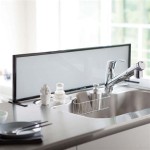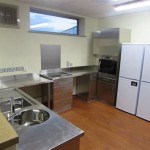White Subway Tile Kitchen: A Timeless and Stylish Choice
The white subway tile kitchen represents a design choice with enduring appeal. Its adaptability and clean aesthetic have cemented its position as a classic option for homeowners and designers alike. Its widespread adoption stems from its versatility, cost-effectiveness, and the ability to complement a wide range of kitchen styles, from the most traditional to the ultramodern.
The term "subway tile" refers to a rectangular ceramic tile, typically measuring 3 inches by 6 inches, although variations in size are readily available. Its origins trace back to the early 20th century, specifically the New York City subway system, where its glazed surface and durable nature made it ideal for a high-traffic environment. The design’s practical advantages quickly translated to residential applications, establishing it as a staple in kitchens and bathrooms.
The color white, in conjunction with the subway tile format, amplifies the versatility of this design choice. White is a neutral color that reflects light, making it an excellent option for kitchens lacking natural illumination. It creates a sense of spaciousness and cleanliness, contributing to an overall feeling of brightness and airiness. This inherent luminosity can be particularly advantageous in smaller kitchens, helping to visually expand the room.
The following points will elaborate on the key features and advantages that make white subway tile a lasting and stylish choice for kitchen design.
Versatility and Adaptability to Diverse Kitchen Styles
One of the most compelling arguments for choosing white subway tile is its remarkable versatility. It seamlessly integrates with a multitude of kitchen design styles, functioning as a neutral backdrop that allows other design elements to take center stage. In a traditional kitchen, white subway tile can be paired with classic cabinetry, such as shaker-style doors, and natural stone countertops like granite or marble. The resulting aesthetic is one of understated elegance and timeless charm.
In a more contemporary or modern kitchen, white subway tile can be combined with sleek, minimalist cabinetry, stainless steel appliances, and concrete or quartz countertops. The contrast between the clean lines of the subway tile and the modern elements creates a visually striking and sophisticated space. The tile's simplicity prevents the overall design from becoming overly busy or cluttered, maintaining a sense of calm and order.
For farmhouse-style kitchens, white subway tile offers a perfect canvas for incorporating rustic elements. Pairing it with open shelving, butcher block countertops, and vintage-inspired accessories creates a warm and inviting atmosphere. The tile's clean lines provide a counterbalance to the more rustic textures, ensuring a balanced and harmonious design.
Even in transitional kitchens, which blend traditional and contemporary elements, white subway tile excels. It can be effectively used to bridge the gap between the two styles, creating a cohesive and unified space. The tile's adaptability allows it to complement both classic and modern features, resulting in a kitchen that feels both familiar and fresh.
Furthermore, the versatility of white subway tile extends beyond the overall kitchen style. It can be used in various applications within the kitchen, including backsplashes, accent walls, and even as a flooring material in specific areas. This flexibility allows for a cohesive and unified design throughout the entire space.
Cost-Effectiveness and Ease of Maintenance
Beyond its aesthetic appeal, white subway tile offers practical advantages in terms of cost-effectiveness and ease of maintenance. Compared to other tiling options, such as natural stone or intricate mosaic patterns, subway tile is generally more affordable. This makes it an accessible choice for homeowners on a budget who still desire a stylish and durable backsplash.
The simple rectangular shape of subway tile minimizes waste during installation, further contributing to its cost-effectiveness. Installation is generally straightforward, making it a viable option for DIY enthusiasts or resulting in lower labor costs if a professional installer is hired.
Maintenance is another area where white subway tile shines. The glazed surface is non-porous, making it resistant to stains, water damage, and mold growth. This is particularly important in a kitchen environment, where spills and splatters are common occurrences. Cleaning is typically a simple matter of wiping the tiles with a damp cloth or sponge and a mild cleaning solution. The smooth, flat surface is easily accessible, preventing the buildup of dirt and grime.
The grout lines, however, can be more susceptible to staining. Choosing a high-quality grout sealant can help to protect the grout and prevent discoloration. Regular cleaning of the grout lines with a grout brush and a specialized grout cleaner will also help to maintain their appearance. Epoxy grout is another option that offers superior stain resistance and durability, although it typically comes at a higher cost.
Overall, the low maintenance requirements of white subway tile make it a practical and appealing choice for busy homeowners who want a beautiful and functional kitchen without the burden of extensive upkeep.
Design Variations and Customization Options
While the classic white subway tile is a timeless choice, there are numerous variations and customization options available to personalize the look of a kitchen. These options allow homeowners to tailor the design to their specific preferences and create a unique and individual space.
One of the simplest ways to customize the look of white subway tile is to experiment with different grout colors. While white grout creates a seamless and minimalist look, contrasting grout colors, such as gray or black, can highlight the tile pattern and add visual interest. Dark grout also has the added benefit of concealing dirt and stains, reducing the need for frequent cleaning.
Another way to personalize white subway tile is to play with different laying patterns. The standard horizontal running bond pattern is a classic choice, but other options, such as vertical stacking, herringbone, or stacked bond, can create a more modern or unique look. Experimenting with different patterns can dramatically alter the overall feel of the kitchen.
The size of the subway tile itself can also be varied. While the traditional 3-inch by 6-inch size is the most common, larger or smaller tiles can be used to achieve different effects. Larger tiles can create a more contemporary and streamlined look, while smaller tiles can add a more intricate and detailed feel.
Adding decorative accents is another effective way to customize white subway tile. This can be achieved by incorporating decorative tiles, such as accent strips or mosaic patterns, into the backsplash design. These accents can add pops of color, texture, and visual interest, transforming a simple backsplash into a focal point.
The finish of the subway tile can also be customized. While glossy finishes are the most common, matte or textured finishes can add a different dimension to the design. Matte finishes can create a more subtle and understated look, while textured finishes can add a tactile element to the space.
Finally, the type of material used for the subway tile can also be varied. While ceramic is the most common and affordable option, other materials, such as glass or porcelain, can offer different aesthetic and functional benefits. Glass subway tile, for example, can add a touch of elegance and sophistication, while porcelain subway tile is known for its durability and water resistance.
In summary, the myriad of design variations and customization options available for white subway tile allow homeowners to create a kitchen that reflects their individual style and preferences, ensuring a timeless and stylish space that will be enjoyed for years to come.

Our Round Up Of Timeless Kitchen Backsplash Styles Hope Miriam Designs

Mastering Modern Simplicity The Art Of A White Subway Tile Backsplash Stone Depot

What Is A Subway Tile Backsplash Lily Ann Cabinets

Mastering Modern Simplicity The Art Of A White Subway Tile Backsplash Stone Depot

Mastering Modern Simplicity The Art Of A White Subway Tile Backsplash Stone Depot
:strip_icc()/149227403_1128522247578130_6231868015445811908_n-8c71c052c7d843b69a24ecc60eb5c213.jpg?strip=all)
21 Subway Tile Backsplash Ideas

6 Ways To Maximize White Subway Tile Remodeling Tips Dreammaker Bath Kitchen Of St Louis Park Mn

Mastering Modern Simplicity The Art Of A White Subway Tile Backsplash Stone Depot

Subway Tiles 5 Ideas To Make Your Backsplash More Interesting

White Subway Tile Backsplash A Modern Classic Direct Stone Source
Related Posts








